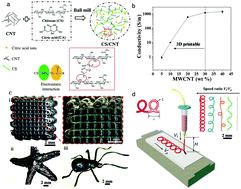3D printing of a self-healing nanocomposite for stretchable sensors†
Abstract
The design of self-healable and stretchable devices from sustainable materials is increasingly attractive for various applications such as soft robotics, wearable sensors, and biomedical devices. In this work, we report a novel multifunctional material with self-healing ability and electrical conductivity based on chitosan (CS) and multiwall carbon nanotubes (CNT). The self-healing of the nanocomposites can be achieved with the assistance of water vapor. The self-healing process is rapid, occurring within seconds to heal the damage. Upon drying, the conductivity can be restored. The nanocomposite is processed by instability-assisted 3D printing at room temperature for producing highly tunable microstructured fibers. The microstructured fibers featuring sacrificial bonds and hidden lengths endow the nanocomposite with high stretchability (strain at break of 180%). Exposure of the CS/CNT microstructured fibers to water vapor can restore their mechanical properties (e.g., flexibility and strength) after healing their broken sacrificial bonds. We make use of this combination of high stretchability and conductivity of the CS/CNT nanocomposite to demonstrate the possibility of 3D printing strain gauges and humidity sensors for organic electronics.



 Please wait while we load your content...
Please wait while we load your content...